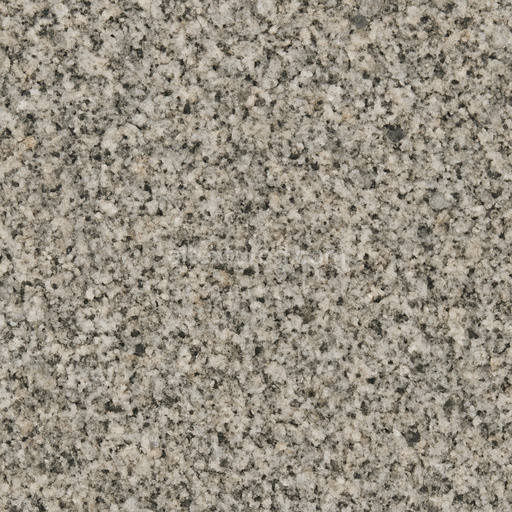The Granular Granite Seamless Texture offers a meticulously crafted representation of natural granite rock, designed to capture the complex interplay of mineral grains and surface features. This texture emulates granite’s inherent composition—a durable igneous stone primarily composed of quartz, feldspar, and mica crystals, tightly bonded in a coarse-grained matrix. The pattern reveals subtle variations in grain orientation and porosity, reflecting weathering effects and micro-structural details that contribute to its authentic roughness and depth. The surface finish balances a slightly polished yet naturally uneven stone look, with nuanced color variations stemming from mineral pigments and oxide layers that create a rich, multidimensional BaseColor (Albedo) channel. The Normal map accurately conveys the granite’s granular relief, while the Roughness channel defines the stone’s semi-matte finish, avoiding excessive glossiness. Ambient Occlusion enhances the perception of crevices and fissures, and the Height/Displacement map adds realistic surface undulations for advanced rendering techniques. The Metallic channel remains minimal, consistent with granite’s non-metallic nature.
This tileable granular granite seamless texture is delivered in ultra-high resolution, up to 8K, ensuring sharp detail even on large-scale surfaces without visible repetition or pixelation. It integrates flawlessly with popular 3D engines such as Blender, Unreal Engine, and Unity, requiring minimal setup for immediate use in environment art, architectural visualization, and concept prototyping workflows. The file format options include PNG and WEBP, optimized for both quality and performance. Users will benefit from the AI-driven texture pipeline that preserves structural consistency and micro-detail, resulting in a production-ready asset that enhances realism and material authenticity in any digital scene.
For best results, it is recommended to carefully match texel density across all assets to maintain uniform texture scale and avoid stretching on UV maps. Adjusting the roughness parameter subtly can help simulate varying weathering conditions—from freshly cut granite to aged, worn surfaces—while fine-tuning height or parallax displacement amplifies the tactile feel of the granular stone. Incorporating this seamless granular granite texture into your material library will accelerate iteration cycles and elevate the visual fidelity of rock textures in your 3D projects, delivering consistent, naturalistic surfaces suitable for a wide range of creative applications.
The AI texture granular granite seamless texture offers a highly detailed, seamless granular granite seamless texture that enhances 3D preview realism through its precise PBR material composition.
How to Use These Seamless PBR Textures in Blender
This guide shows how to connect a full PBR texture set to Principled BSDF in Blender (Cycles or Eevee). Works with any of our seamless textures free download, including PBR PNG materials for Blender / Unreal / Unity.
What’s inside the download
*_albedo.png — Base Color (sRGB)*_normal.png — Normal map (Non-Color)*_roughness.png — Roughness (Non-Color)*_metallic.png — Metallic (Non-Color)*_ao.png — Ambient Occlusion (Non-Color)*_height.png — Height / Displacement (Non-Color)*_ORM.png — Packed map (R=AO, G=Roughness, B=Metallic, Non-Color)

Quick start (Node Wrangler, 30 seconds)
- Enable the addon: Edit → Preferences → Add-ons → Node Wrangler.
- Create a material and select the Principled BSDF node.
- Press Ctrl + Shift + T and select the maps
albedo, normal, roughness, metallic (skip height and ORM for now) → Open.
The addon wires Base Color, Normal (with a Normal Map node), Roughness, and Metallic automatically.
- Add AO and Height using the “Manual wiring” steps below (5 and 6).
Manual wiring (full control)
- Create a material (Material Properties → New) and open the Shader Editor.
- Add an Image Texture node for each map. Set Color Space:
- Albedo → sRGB
- AO, Roughness, Metallic, Normal, Height, ORM → Non-Color
- Connect to Principled BSDF:
albedo → Base Colorroughness → Roughnessmetallic → Metallic (for wood this often stays near 0)normal → Normal Map node (Type: Tangent Space) → Normal of Principled.
If details look “inverted”, enable Invert Y on the Normal Map node.
- Ambient Occlusion (AO):
- Add a MixRGB (or Mix Color) node in mode Multiply.
- Input A =
albedo, Input B = ao, Factor = 1.0.
- Output of Mix → Base Color of Principled (replaces the direct albedo connection).
- Height / Displacement:
Cycles — true displacement
- Material Properties → Settings → Displacement: Displacement and Bump.
- Add a Displacement node: connect
height → Height, set Midlevel = 0.5, Scale = 0.02–0.08 (tune to taste).
- Output of Displacement → Material Output → Displacement.
- Add geometry density (e.g., Subdivision Surface) so displacement has polygons to work with.
Eevee (or lightweight Cycles) — bump only
- Add a Bump node:
height → Height.
- Set Strength = 0.2–0.5, Distance = 0.05–0.1, and connect Normal output to Principled’s Normal.
Using the packed ORM texture (optional)
Instead of separate AO/Roughness/Metallic maps you can use the single *_ORM.png:
- Add one Image Texture (Non-Color) → Separate RGB (or Separate Color).
- R (red) → AO (use it in the Multiply node with albedo as above).
- G (green) → Roughness of Principled.
- B (blue) → Metallic of Principled.
UVs & seamless tiling
- These textures are seamless. If your mesh has no UVs, go to UV Editing → Smart UV Project.
- For scale/repeat, add Texture Coordinate (UV) → Mapping and plug it into all texture nodes.
Increase Mapping → Scale (e.g., 2/2/2) to tile more densely.
Recommended starter values
- Normal Map Strength: 0.5–1.0
- Bump Strength: ~0.3
- Displacement Scale (Cycles): ~0.03
Common pitfalls
- Wrong Color Space (normals/roughness/etc. must be Non-Color).
- “Inverted” details → enable Invert Y on the Normal Map node.
- Over-strong relief → lower Displacement Scale or Bump Strength.
Example: Download Wood Textures and instantly apply parquet or rustic planks inside Blender for architectural visualization.
To add the downloaded texture, go to Add — Texture — Image Texture.

Add a node and click the Open button.

Select the required texture on your hard drive and connect Color to Base Color.


